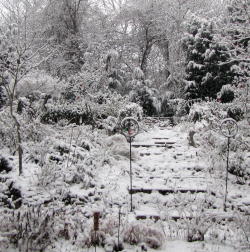As the path is followed that leads to the shed the sound of buzzing and the feel of thrumming cannot be ignored. What appears to be all the same kind of bee is gathering the pollen produced by the white flowers. If there is a fragrance to these flowers, we wouldn’t know of it, the presence of the insects flitting around prevents that deep inhale of nose in blossom. In fact, just the taking of these photographs caused some concern about being stung. The numbers of bees sipping nectar is astounding. The whole area vibrates as though it were a machine.
We are not afraid of bees in the garden, even though stings have occurred. But that time it was my own fault for wearing a long flowing skirt and walking up the steps while the ajuga was in bloom. The large bumblebees love those blue spikes on the ajuga and one flew up inside my skirt and had a panic attack, stinging me multiple times on the thigh. He was very frightened. I lifted my skirt above my waist for him to fly out to freedom, thankful for the privacy of the back gardens. But these little bees are something different, and seem to only be on the pyracanthas. Can anyone out there in the blogdom identify him?
Pyracanthas are a shrub that has been grown at every house we have owned. In Pennsylvania, California, Tennessee, Texas, and back to Tennessee again, we have planted at least one. The reason for this is the memories of having three large pyracanthas at my childhood home in Oklahoma. They were planted along the foundation of our white stucco house, and were as large as the ones we now have growing along the fence. The reddish orange berries added more interest long after the flowers had faded. Many birds like to build their nests in the thorny braches in addition to dining on the berries.
The leaves are semi evergreen, whatever that means. During the winter this lush leafiness is not apparent, although a few leaves do remain, turning darker and more leathery with the cold. The berries do not persist past fall, being devoured by the hungry hoardes of cardinals among others. Maybe that is one reason we have so many cardinals that live in the garden the year around, the berry bonanza provided by the pyracanthas.
Wings neatly crossed and laying flat on his back, the saddlebag pollen sacks on his legs bulging, our friendly bee is doing a good job of insuring a bounteous berry production this fall. Our hats off to you and your cohorts! Maybe this post will help us to know you and your brethren better if some knowledgable reader will leave a message as to your name.









Frances,
I never fully appreciated pyracanthas before and never knew they were so attractive to bees. Only one gardening friend has them and hers is a poor specimen compared to your 50 foot wall of bird and bee food!
Hoping someone will identify the bee type you have.
Nice shots of bee and flower.
Gail
I cant help you with the name but I did like the story
I can just imagine the humming and vibration of all those bees busy at work. Sorry I can’t identify that bee, but if you caught JUST one, perhaps someone at your local cooperative extension service could help you identify it?
We all have a plant or two that we have to have growing in our garden, wherever that might be, don’t we? We find a special place for it in our new gardens, just as soon as we can.
Carol, May Dreams Gardens
I am going to have to dash out before work to see if your pyracantha is blooming Frances. We only have one bush. It is great though. I don’t know what kind of bee that is. It is nice to have these hard workers in your garden. The Robins, Mockingbird, Catbirds and Cardinals all tussle over the pyracantha.
The male Mocker wanted to nest there this spring but he couldn’t convince his lady to do so. They are across the street in a thicket of honeysuckle and wisteria. I don’t mind because they bring their young to our garden. It is such fun to watch them.
Frances, that’s a lovely shrub. Good on you for helping the bee population!
I can’t identify the bee but I’m confident someone will be able to tell you what it is.
Those pyracantha are awesome and would provide good security as well as privacy. I think the bloom looks like red tip blooms; which to bees love too. Wish I could identify the bee, but I can’t. Bee careful of those bees when wearing skirts!
Great photos of those little pollinators! The pyracanthas are lovely, and I believe the butterflies like them as well. 🙂
Hi Gail, thanks. Not everyone loves the pyracanthas, they are very thorny. There are some varieties that don’t grow as large, but I wanted the big ones for privacy and security along the fence. They are perfect for that task. The bee activity is almost scary, they have flown into my as I am going up the path to the shed, hitting me with the thump, kind of cool.
Thanks Helen, glad you enjoyed it.
Hi Carol, thanks for the good idea about the extension office. I have their email and could send them the photos if no one knows what it is, not that it matters, but it is a different kind of bee. I have heard many gardeners say they have a plant that they simply must have, usually a reminder of their childhood, kind of cool.
Hi Lisa, glad you stopped by before work. The pyracantha makes a great place for a nest. We have seen robins in there other years, not sure what is in there now, but there is room for plenty. One year we had a large papery hornet’s nest and I was attacked while pruning, didn’t see it until too late. I didn’t want to write about it as it was awful. I got stung many times and ran into the shed and locked the door. The hornets were banging against the door! We are on the lookout for those guys now.
Hi Linda, thanks for visiting. When the pyracanthas were planted, I had forgotten about the bees, and the bushes were so small. Last year the flowers were frozen with the late frost so we had few berries, and few bees come to think of it. This year is a record breaker for blooms and bees, the berries should be plentiful also.
Hi Tina, it is an excellent security and privacy shrub, an open chain link fence doesn’t really help with either. I don’t walk the paths when wearing a long skirt, or hold it tight against my legs. The stings really hurt and my leg was swollen and hot for a week, a lesson learned the hard way.
Nancy J., thanks. Good to know about the butterflies, I have seen some around and about, but haven’t had the camera or tried to get a photo. They don’t stay still, I will have to snap on the run!
Frances, great post and pics as always and if none of the bloggers know the bee but you find out from the extension, please let us all know. Interesting.
Thanks Jean. I will wait until Monday, then send a photo to the extension office. In the meantime I might try searching bee photos online, although there are many types of bees, I think. Thanks for stopping by.
I just wanted to let everyone know that the photos of this bee have been sent to our helpful extension office. I have tried to search online for an ID, but had no luck. It seems to be a honeybee of some sort, by the pollen bags and size. There is a little furriness on the abdomen too. I will post any info as it becomes available.
Very interesting post, Frances. I was going to suggest you visit Cheryl’s blog at My Wildlife Sanctuary who knows a lot about bees. But she lives in the UK, and maybe these are American bees…The extension office no doubt is your best bet.
Just read yesterday’s post, too–enjoyed your clever perspective as well as the beautiful photos.
Me again, sorry. I meant to thank you for visiting my blog and identifying my shrub as a quince. I intend to give it a good haircut later in the season as you suggested.
Hi Rose, leave as many comments as you want ;-> Thanks, I agree that my extension office has the best chance of knowing what the bees are. I looked on google and couldn’t find anything just like it. I want to think they are a type of honeybee, but hopefully the ext office will know. You are most welcome. Our quince is a great source of color in early spring, lasting for a couple of months. Some people have mistaken it for an azalea, it is kept that size. Look out for thorns when pruning it!
As usual, lovely photos. The shot of Hazel is great–I love the angle and her expression. Black cats can be hard to photograph because it’s hard to see their features. Neither of my cats is particularly fond of non-cat food.
~ Monica
Hi Monica, I thought you were commenting on the flowers for cutting post, hope you come back here to see the reply. Hazel is very hard to photograph, even the one shown isn’t very good. The flash makes her eyes look crazy and her fur handles the light weird. She won’t eat canned cat food, or meat or tuna, just dry cat food and soap, in addition to plants.
Hi Monica, your comment is on the pyracantha post. ;->
I have a pyracanthas that does not bloom or have berries. It is at least 5 ft tall and has thorns on it. I have never pruned it. What could be causing it not to bloom. The pot I bought it in said pyracanthas.
Hi Janet, that sounds like pyracantha with all those thorns, it is a bit of a monster in that regard. I think that’s why the birds love it so, great protection from predators. Mine have been in the ground ten years. I do think it takes them a while to get mature enough for the flowering and berry production. You didn’t say how old yours was, so maybe just give it a little more time. Some years we have had no berries if there was a late frost that killed them while the tree was in bloom, like our Easter 2007 deep freeze. But the next year was the best ever, as with many of the damaged plants.
Frances